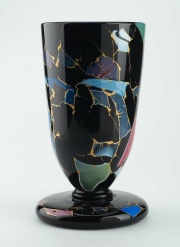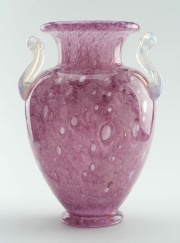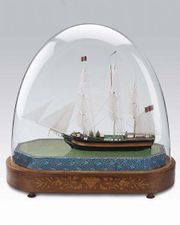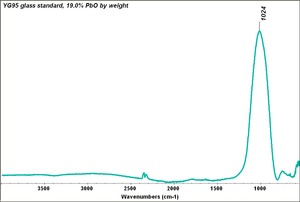Glass
Description
A hard, brittle, amorphous inorganic material made by fusing Silica at high temperatures with two or more metal oxides. Though rare, glass is also naturally produced by volcanic activity (Obsidian), meteor strikes (Tektite) and lightening strikes (Fulgurite). Glass was first made in the Middle East during the 3rd millennium BCE. For glass manufacture, silica is obtained from Sand, Flint, Quartz or broken bits of glass. The fusion point of silica is lowered by mixing it with one or more fluxes (Soda ash, Potash, Lime and oxides of lead, lithium, cerium etc.) Typical glass, such as soda-lime, contains about 75% silica, 15% soda and 10% lime. The components are melted to approximately 700-1000 C, then formed into various shapes by blowing, casting, floating, pressing, or rolling. The glass is cooled to a rigid Vitreous material. As glass ages, it can become Crystalline or devitrify. Buried glass can have an iridescent surface caused when the metal oxides are dissolved leaving small plates of silicic acid on the surface. Glass is normally colorless and transparent. Small amounts of inorganic materials are used to make glass colored or opaque (see Glass colorants).
Synonyms and Related Terms
common glass; sklo (Ces.); glas (Dan., Ned., Nor., Sven.); Glas (Deut.); vidrio (Esp.); verre (Fr.); vetro (It.); vidro (Port.); sticla (Rom.); ; Carrara® glass [PPG]; Pyrex
See also: Agate glass; Alumina glass; Amber glass; Basalt glass; Borosilicate glass; Cameo glass; Canary glass; Carrara glass; Case glass; Crackle glass; Copper ruby glass; Crown glass; Crystal glass; Cylinder glass; Dichroic glass; Favrile glass; Flash glass; Flint glass; Gold ruby glass; Green glass; Ground glass; Heat-resistant glass; Iridescent glass; Lead glass; Lime glass; Luxfer prism glass; Milk glass; Opal glass; Optical glass; Plate glass; Potash glass; Potash-lead glass; Safety glass; Silica glass; Soda glass; Stained glass; Structural glass; Tempered glass; Tiffany glass; Water glass; Window glass; Glass bead; Glass fabric; Glass fiber; Glass paper; Glass rot; Glass wool; Microballoon
Applications
Risks
Physical and Chemical Properties
- Insoluble in all solvents except hydrofluoric acid.
- Density (glass) =2.4-2.8
- Density (flint) =2.9-5.9
Resources and Citations
- R.Hummel, Understanding Materials Science: History, Properties, Applications, Springer, New York, 1998.
- K.Cummings, "Glass", The Dictionary of Art, Grove's Dictionaries, New York, 1996.
- Encyclopedia Britannica, http://www.britannica.com Comment: glass" [Accessed October 17, 2001]. gives date as 2500 BC in History of Glassmaking entry
- Wikipedia: http://en.wikipedia.org/wiki/Glass (Accessed Jan. 25, 2006)
- R. J. Gettens, G.L. Stout, Painting Materials, A Short Encyclopaedia, Dover Publications, New York, 1966
- Dictionary of Building Preservation, Ward Bucher, ed., John Wiley & Sons, Inc., New York City, 1996
- Tom Rowland, Noel Riley, A-Z Guide to Cleaning, Conserving and Repairing Antiques, Constable and Co., Ltd., London, 1981
- Michael McCann, Artist Beware, Watson-Guptill Publications, New York City, 1979
- Jack Odgen, Jewellery of the Ancient World, Rizzoli International Publications Inc., New York City, 1982
- Susan E. Schur, Conservation Terminology: A review of Past & Current Nomenclature of Materials, Technology and Conservation, Spring (p.34-39); Summer (p.35-38); Fall (p.25-36), 1985
- CRC Handbook of Chemistry and Physics, Robert Weast (ed.), CRC Press, Boca Raton, Florida, v. 61, 1980 Comment: density for common glass=2.4-2.8; flint glass=2.9-5.9



